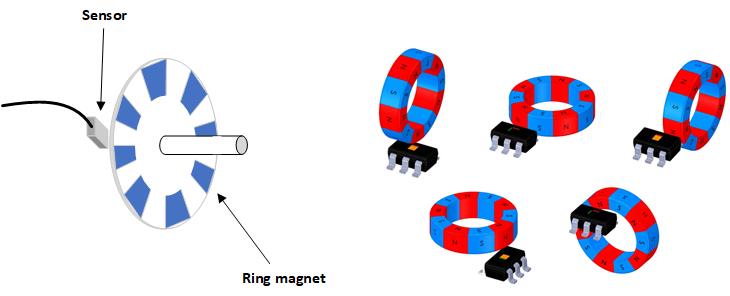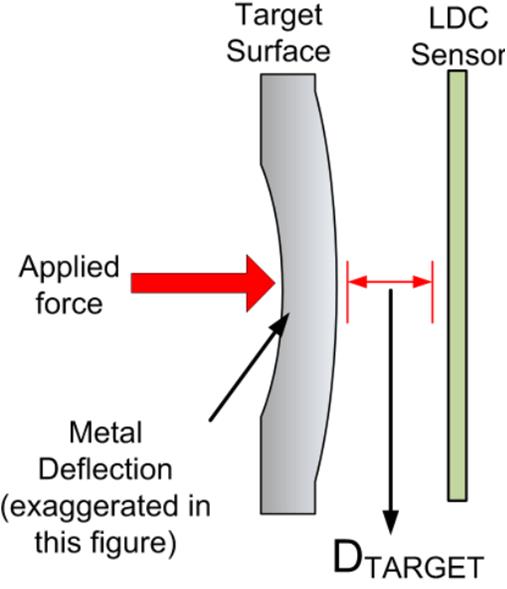SBOA549A april 2022 – april 2023 LDC3114 , TMAG5110 , TMAG5111 , TMAG5124
1 Application Brief
Three-Position Sensing Solutions for Home Appliances
Consumer products with moving parts have undergone a transformation from being purely mechanical to electromechanical products with electronic controls using integrated circuits (ICs). One such evolutionary example is the washing machine having had humble beginnings as a stick – yes, a paddle-shaped stick – that pounded the grime right out of the clothes laid against a river rock. Since medieval times, the washing machine has gone from a stick, to a tub and washboard, to adding a wringer, to motorizing the tub and wringer, and eventually to the automatic washer in 1947 that resemble the products of today.
Current appliances use many types of sensors to measure things like water level, knob selectors, and temperature. The introduction of the microcontroller (MCU) in 1990 made it possible to gather sensor information from appliances, to make informed decisions based on this new set of data. For example, when vibrations cause clothes to shift to one side of a washing machine drum during the spin cycle, the MCU slowly rotates the drum in oscillating motions until the clothes are evenly distributed before proceeding with high-speed spinning. This prevents damage to the washing machine and to the surroundings.
This document presents three sensing innovations enabled by Hall-effect and inductive position sensors that can improve functionality, reliability, accuracy, and system flexibility.
Sensing Solution Number 1 – Rotary Encoding With Added Placement Flexibility
In washing machines and dryers, rotary encoding determines the speed and direction of the spinning drum - information that is essential for the MCU to manage different wash modes and spin cycles. Implementing rotary encoding with a single device that integrates true 2D latches provides higher flexibility in sensor placement compared to sensors with two Hall-effect latches. 2D latches have the capability to monitor all three sensitivity axes, allowing a designer to choose the specific device with the two direction sensitivities needed depending on the orientation of the magnet. Without this capability, two separate sensors pose a challenge in a system design, because in some cases one sensor has to be oriented in one direction and the other sensor in another direction.
Although rotary encoding is not new, having the ability to place the IC where it is most convenient is an advantage that many dual-latch, Hall-effect sensors do not possess. Additionally, having 2D latches onboard enables further flexibility in ring magnet pole widths, as shown in Figure 1. See the TMAG5110 and TMAG5111 dual 2D latches that are designed to provide digital quadrature signatures with ease and flexibility.
 Figure 1 Rotary Encoding Using Ring
Magnets, and Various Sensor Placements
Figure 1 Rotary Encoding Using Ring
Magnets, and Various Sensor PlacementsSensing Solution Number 2 – Touch Buttons With Force Detection
Unsurprisingly, home appliances work in not-so-clean environments. A hermetically sealed touch button is the best design for environments prone to food spills (cooktop) and grease buildup (range hood). Inductive technology, which indirectly but very precisely measures the distance from the sensor coil to a metal touch button, is a great option for this use case because it is possible to create the touch buttons using a solid sheet of metal, isolating the exterior environment from the sensor. Due to the inherent capability of this technology to measure targets in micrometer range, this allows for very precise force detection that offers additional button functionality beyond the simple on or off. Figure 2 shows how the implementation of inductive technology can create a seamless interface.
 Figure 2 Inductive Sensing Technology
for
Figure 2 Inductive Sensing Technology
forTouch Buttons
Inductive sensing technology (LDC3114) offers:
- Complete separation from harsh exterior environments
- Contactless sensing for high reliability
- Imperviousness from oil, grease, and water, which have no effect on performance
- Consistent functionality even if the user is wearing gloves
- Longevity, because the sensors self-adjust to wear, accidental indentions, and environmental changes
- The ability to use a sheet of stainless steel for multiple touch buttons
- Additional touch-button
functionality through the implementation of force touch
| Mechanical Switch | Reed Switch | DRV5032 Hall-Effect Sensor | TMAG5124 Hall-Effect Sensor | |
|---|---|---|---|---|
Pros |
Lowest cost approach |
Pulsing the MCU general-purpose I/O powers the device, enabling variable sampling operation. |
|
|
Cons |
Wear and tear due to continuous use potentially causing premature failures. |
|
|
|
Sensing Solution Number 3 – Open and Close Detection With Extended Cabling Capability
Mechanical or contactless magnetic switches detect door opening and closing in home appliances such as refrigerators, washing machines, and dryers. Budget-friendly appliances usually use mechanical or magnetic Reed switches due to their price point. These switches have worked for decades, but the switches come with challenges (see Table 1).
High-end appliances often use magnetic Hall-effect sensors because these sensors offer several advantages (see Table 1, which includes two of TI’s Hall-effect sensors). The DRV5032 is considered a low-power device because this device is internally duty-cycled at the lowest rate of 5 Hz. Other devices within the TI portfolio can be power cycled at even lower rates, with the caveat that the designer must wait for the power-on time to begin the sampling.
Using a two-wire current-output device such as the TMAG5124 provides significant advantages over voltage-output devices as shown in Table 1. Figure 3 shows the connection for the high-side configuration, along with a small PCB implementation of the TMAG5124. Keep in mind that although two-wire Hall-effect sensors do require a PCB, these are typically not large and bulky.
 Figure 3 TMAG5124 Two-Wire Connection
and Small PCB Implementation
Figure 3 TMAG5124 Two-Wire Connection
and Small PCB ImplementationThe position sensing designs provided in this application brief show how Hall-effect and inductive sensors are used in home appliances. For specific appliance information see Table 2. The table includes a list of appliances along with functions that can be achieved using TI's position sensing devices. For more information and resources on how to use these functions in a design, follow the links in the table. Additional resources are found in the References section where key documents are provided to get started on a design.
| Appliance | Functions | Link |
|---|---|---|
| Cooktops | Rotary Dials and Knobs | E2E™ FAQ |
| Ovens | Touch Buttons and Rotary Dials and Knobs | E2E™ FAQ |
| Range Hoods | Touch Buttons and Rocker Switches | E2E™ FAQ |
| Refrigerators | Open and Close Detection and Dispenser Levers | E2E™ FAQ |
| Dishwashers | Open and Close Detection and Touch Buttons | E2E™ FAQ |
| Washers and Dryers | Open and Close Detection, Drum Speed Detection, Water Level, and Touch Buttons | E2E™ FAQ |
References
- Texas Instruments, Reducing Quadrature Error for Incremental Rotary Encoding Using 2D Hall-Effect Sensors Application Note
- Texas Instruments, BOOST-LDC3114EVM, LDC3114 evaluation module for inductive sensing tool page
- Texas Instruments, LDCTOUCHCOMCOILEVM, Inductive Touch Sensor Coil Evaluation Board tool page